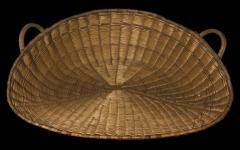ENGLAND: THE OTHER WITHIN
Analysing the English Collections at the Pitt Rivers Museum
Calendar-related objects
Harvest-time.
Alison Petch,
Researcher, 'The Other Within'
Harvest time was one of the busiest and most important in the agricultural calendar-without a good harvest people starved. Many traditions have grown up around the need to ensure that the crops were plentiful and the ground fertile. It was also a time that all farmers needed the cooperation of their farm-hands and when many workers could earn double their usual wage, and do twice the work. (Roud, 2006:278) Harvest-time was the focus of much activity, and its importance is probably the reason why we have rich collections from all over the world (including England) of harvest-related artefacts. Traditionally, harvesting would have taken place in August but latterly the season has spread so that it now occurs at any point between July and September.[Hutton, 1996:332]
In England there are many traditional objects associated with harvest-time and the Pitt Rivers Museum collections include several examples. The most famous traditional objects are probably the so-called corn-dollies, or harvest trophies. In addition we have extensive collections of harvesting agricultural tools, hop tallies, hay-making equipment and items connected with harvest workers.
- Agricultural tools used for harvesting
- Hop tallies
- Food and drink for harvest workers
- Haymaking tools
- Harvest trophies
With increased mechanisation, and the move of most English people from rural to urban areas, harvest became a less important marker in the events of the year. Hutton documents how the number of people directly involved in harvesting decreased: '...to harvest and thresh a six-quarter wheat crop at 10 acres a day required 130 men in the 1840s, thirty-three in the 1870s when the horse-drawn mechanical reaper was introduced, and three in the 1940s when combine harvesters had come into use'. [1996:346] For most people today in England, their only link will be with harvest festivals held in their local church (if they are churchgoers).
Further reading
http://www.reading.ac.uk/Instits/im/index.html
Christina Hole. 1941-2. English Custom and Usage. London: Batsford
Ronald Hutton. 1996. The Stations of the Sun: A history of the Ritual Year in Britain Oxford: Oxford University Press [especially pages 332-347]
Steve Roud. 2006 'The English Year: A month-by-month guide to the nation's customs and festivals, from May Day to Mischief Night' London: Penguin Books [especially pages 278-287]
